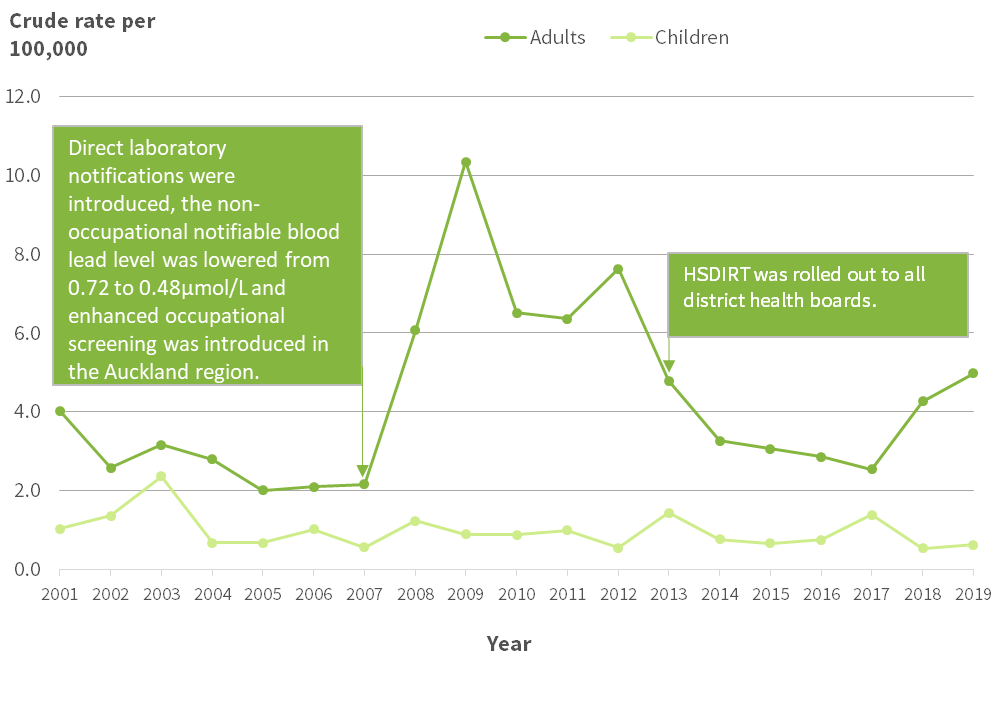Hazardous Substances Disease and Injury Reporting Tool (HSDIRT)
Why notify?
By law, the following must be notified to the Medical Officer of Health:
- Injuries and diseases due to hazardous substances (See What to Notify?) (Hazardous Substances and New Organisms Act 1996)
- Lead absorption where the blood lead level is greater than or equal to 0.24μmol/l (Health Act 1956), and
- Poisoning arising from chemical contamination of the environment (Health Act 1956)
The Medical Officer of Health and Public Health Unit staff will assess the notification and determine if further follow-up with the patient is required.
Primary care notifications allow identification of substances which are causing harm, and can lead to public health action to prevent disease or injury. For example, exposure to lead from deteriorating lead-based paint can be reduced through a range of remedial actions. Some controls may be regulatory; for example, the sale of highly alkaline dishwashing powders was prohibited in 2007 following increased reports of oesophageal and upper airway injuries in children who ingested this powder
About the tool
An electronic notification system exists for general practices to report cases of disease and injury related to exposure to hazardous substances, including lead absorption. Massey University’s Environmental Health Intelligence NZ developed the HSDIRT in conjunction with bestpractice Decision Support (BPAC), which develops forms and decisions support tools which are linked to a GP’s patient management system.
There were 204 notifications of lead absorption in 2019. For adults, the notification rate of lead absorption has increased by 100% from 2017, while the notification rate for children (0 to 14 years) has remained relatively constant (Figure 1).

Figure 1. Lead absorption notification rate, by year
What to notify?
Any diseases or injuries that are caused by exposures to hazardous substances should be notified. A hazardous substance is anything that can explode, catch fire, oxidise, corrode or be toxic to humans, as defined in the Hazardous Substances and New Organisms Act 1996. This definition does not include medicines in finished dose form (and therefore over-the-counter and prescription drug overdoses), alcohol when classified as a food, chemical toxins associated with food, nor radioactive materials as these are covered by different legislation. Manufactured articles other than those including substances with explosive properties such as fireworks are also not included (eg, batteries).
Examples of cases that should be reported:
- A fireworks injury
- Ingestion of cleaning products or cosmetics by children
- Poisoning with agrichemicals (including spraydrift incidents)
- Unintentional carbon monoxide poisoning
- Illness caused by exposure to solvents or chlorine
- Contact dermatitis due to chemicals
- ‘Huffing’ (inhaling) of butane
How to notify?
Look for the “Hazardous Substances and Lead notifications” module on the bestpractice Decision Support dashboard. Submitting the form will send it to your local Medical Officer of Health via a secure system.
If your practice does not currently have access to this electronic form, contact your local Public Health Unit to notify them of a case.
Hazardous Substances Surveillance System (HSSS)
The team at the Environmental Health Intelligence Programme NZ, Massey University, run a hazardous substances surveillance system for New Zealand. This system monitors diseases, injuries and deaths from hazardous substances exposures.
The surveillance system includes information from the following datasets:
- deaths (Mortality Collection)
- hospitalisations (National Minimum Dataset)
- GP visits related to hazardous substances (HSDIRT notification tool)
- notifications of lead absorption
- hazardous substances incidents (NZ Fire Service)
- calls to the National Poisons Centre.
For more information and useful resources, visit Hazardous substances surveillance
Featured module

The Depression in Young People module addresses the identification of common mental disorders and the management of depression in primary care.
For more modules see the full list of standard modules.
Latest News
ACC18 Enhancements - Effective 27 November
Calendar, Printing and ACC Identifiers
In response to feedback, the online ACC18 continues to launch enhancements; the following will be available from 27 November.
Fitness for Work Tab - Calendar: Moving the mouse over the calendar for longer periods has been made easier.
Declaration Tab - ACC Identification: There will be a reduction in the number of identifiers from five to four; no direct impact on the Provider.
If you are one of the over 2000 Practitioners who regularly use the online ACC18; thank you. If you are not then now would be a good time to begin, noting that additional return to work assistance for patients is offered solely through this online form. Self service for setting up and using the online ACC18 is available at www.acc.co.nz (use keyword eACC18 Self Service). However, feel free to contact ACC at 0800 222 994 or ebusinessinfo@acc.co.nz for more personalised support.
Most Popular Modules
The five most popular modules in June were:
- Patient Prompt
- The Common Form
- e-Referral System
- ACC 18 Form
- CVD Quick Screen
To see more, go to the Statistics page.
Getting Started guide
The Getting Started guide is a good place to start if you are new to bestpractice Decision Support. The articles in the guide provide a quick and focussed introduction to the areas of most interest to new users of bestpractice.
About BPAC Inc
bestpractice Decision Support is produced by BPAC Inc. To find out more about us, click here.







